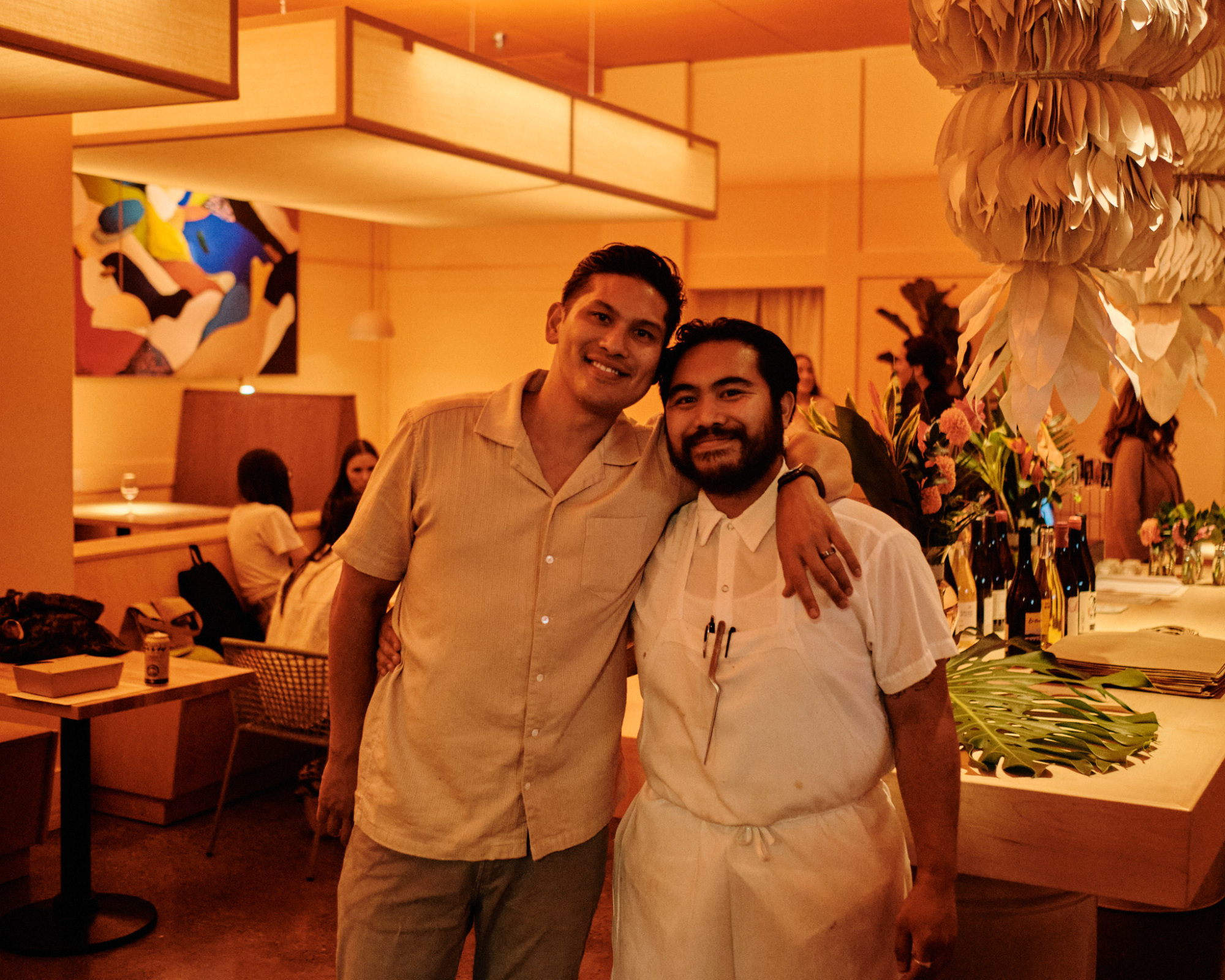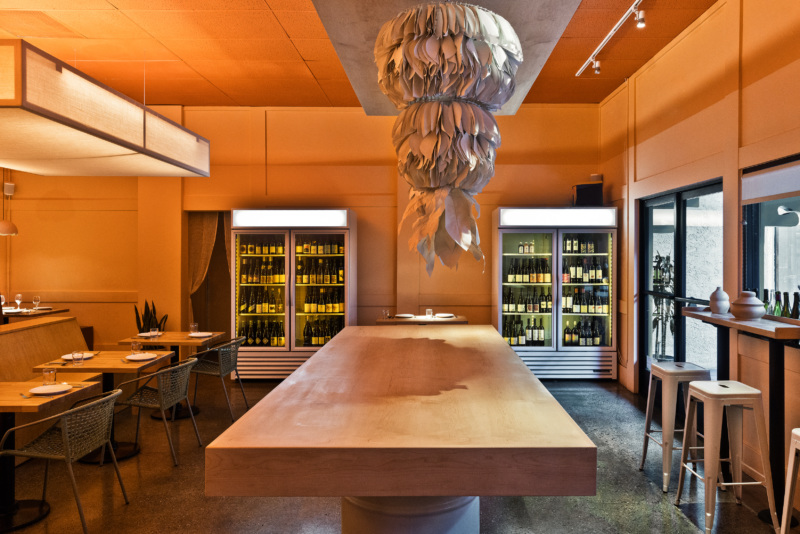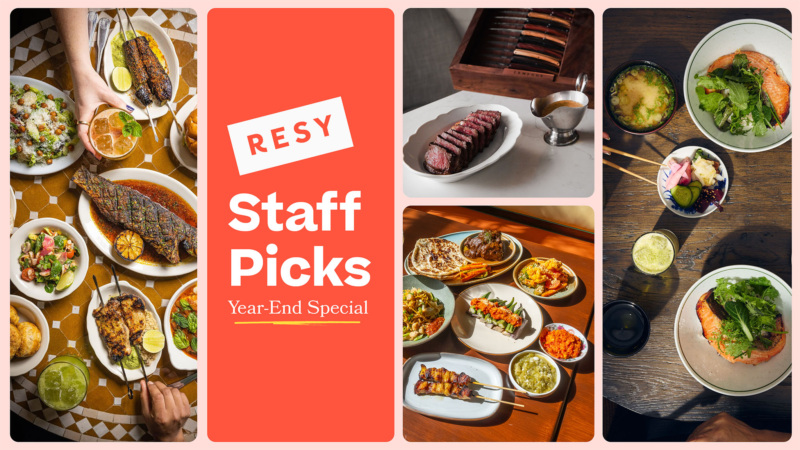
It’s ‘Just a Roast Chicken,’ and Lasita Wants It That Way
When is a roast chicken more than just a roast chicken? When is the screaming curveball of the pandemic an opportunity to launch the restaurant you’ve spent years dreaming about? When is the simplest dish in fact a subtle conversation about ancestry, artistry, and the joy of margarine? The answer: When you’re Chase Valencia and Nico De Leon.
They’re partners in Lasita, the Chinatown hot spot that evolved out of their acclaimed Filipino restaurant Lasa. With that transition, which occurred under the shadow of COVID after the joint had successfully pivoted to takeout, Valencia and De Leon went from “casual fine dining” to … casual dining, dropping the “fine” entirely.
Since then, Lasita has continued to evolve. Thanks to a fantastic, off-kilter wine list, it has become, according to Valencia, “a wine bar that happens to serve Filipino rotisserie.” That might be a bit of an undersell, but Valencia and De Leon like to underpromise and overdeliver. Here, the duo sit down for a talk about chicken inasal, pairing wine with lechon, and the future of Filipino food.
This interview has been lightly edited for length and clarity.


Resy: How and when did you two first meet? And what made you decide that you wanted to be in the restaurant business together?
Nico De Leon: It was 2013. Chase’s brother, Chad, and I were both in San Francisco. We weren’t working together but we had mutual friends, both in the food industry and outside of it. We ended up meeting each other and hitting it off. Chad is a musician and artist. I happened to be a fan of his music. We realized we had all these similarities, not just in our careers, but in our cultures — being Filipino American chefs, and the youngest in our families — multiple things drew us together.
Chad and Chase had this concept called Lasa, a re-exploration of Filipino food from a young Filipino American-slash-California lens. They were hoping to start it as a pop-up in Los Angeles, and Chad asked me to be his sous chef. We started doing some backyard events, which led us to become more serious with the project, and we eventually looked for brick-and-mortar opportunities.
So, Lasa opened in April 2017. How and when did it become Lasita?
Chase Valencia: We were working on the idea of Lasita in the background for several years. The pandemic was an opportunity for us to give it a shot. During COVID, we started serving chicken inasal and pork belly lechon out of our takeout window. It was a hit. People were really into it. One big “aha moment” was when we started seeing the same guests every week. With Lasa, I’d see them once every three months. It was a celebratory thing. With Lasita, I’m seeing people once a week. We were part of their routine, their everyday. It was so gratifying. We decided to take the leap and transform the space into Lasita fully, and we opened our doors in July 2021.
De Leon: Chad wanted to focus on other things, primarily his family. So, he dissolved himself of his position here, and I essentially took over as co-owner.
How did you come to the decision that you were done with Lasa? And on an emotional level, was that a hard choice, did it feel like the natural thing to do?
Valencia: I would be lying to you if I told you it was easy. Lasa was a huge part of this space’s identity. However, the pandemic [forced] a lot of restaurants to really think differently. It was almost like we had to give it a shot. Like I said, Lasita was something Nico and I were working on in the background, and it just felt like this was the moment to take the leap.
Can you compare and contrast the vibe and the menu of Lasa and Lasita?
De Leon: Let’s talk about the space. Lasa was pretty moody. It was painted this warm green, and decorated with a lot of tchotchkes that you would find at your Lola’s house. Lola is a Filipino grandma. There were photographs of Chase and Chad’s family in black and white. There were Filipino-inspired ceramics. There were pieces of bamboo and old wood. It conveyed this sense of coming into someone’s home, but the food was contemporary Filipino American. Chad and I were exploring not just dishes we grew up on, but dishes we’d never had from our diaspora, trying to decipher them and then convey them in our own light.
At Lasita, however, the food is really humble. If you strip it all away, it’s just some rotisserie proteins, some vegetable sides. It’s still very much intentional and chef-driven, but we took the bells and whistles away. The vibe is different from Lasa. You come into Lasita, and it’s …
Valencia: Like you’re on vacation.
De Leon: Yeah. We like to call it a Manila-inspired sunset in here. The music is always loud. It feels like a Parisian wine bistro but the food is obviously Filipino. And the wines complement the menu completely. Also, the pandemic allowed us to essentially double our footprint as a restaurant. We are able to build out this patio that we didn’t have with Lasa. Not only does that help financially, but it adds to this vacation vibe.


Tell us about the chicken inasal, the inasal monok. Where does it originate? How would you describe the dish?
De Leon: It’s a humble grilled chicken dish that originates in Bacolod, which is in the Southern end of the Philippines, on the island of Negros Occidental. They marinate [the chicken] in a mixture of coconut vinegar, local chiles that are comparable to Thai chiles, ginger, lemongrass, annatto, garlic, bay leaf, and black peppercorns. It’s basted in margarine — they use margarine a lot in the Philippines — that’s been fortified with those same spices, and heavily colored with annatto and turmeric. Then it gets grilled. The final product is this beautiful roasted red, almost brick color. You usually just eat it with chicken fat rice and dipping vinegar. I wanted to honor its tradition, so we do all of that, except we cook it on the rotisserie, then we mark it on the grill to mimic the flavor that you would get in the Philippines. It’s extremely juicy, crispy, and buttery. It’s the dish that I’m most proud of, even though it’s one of our most humble.
We know you call it “just a roast chicken,” but it feels like you might be underselling it.
De Leon: And maybe that’s what I want to do. People know what roast chicken is. They don’t expect to be wowed by it, which is inspiring for me. People will order this thing nonchalantly, not expecting much, and then they get slapped in the face with all the flavor and juice that they didn’t think a roast chicken could have. I think once you nail a roast chicken, you feel like you can do anything.


What about the lechon? How do you make that your own?
De Leon: The lechon that we do is from the island of Cebu. What they do in Cebu is focus on pork belly. They stuff it with lemongrass, ginger, garlic, onion, black pepper, and salt. Then they tie it up, roll it, and slow-roast it over charcoal. That was a revelation when Chase and I did our personal explorations of the Philippines. We felt that specific style of lechon was underseen and underappreciated in America, or in California. There were very few places you could find just the lechon belly.
Valencia: The idea of doing chicken and lechon was very intentional. We specifically sought out those two proteins to highlight. One large reason is because it’s recognizable, accessible, and identifiable. Let’s be honest, we’re still in the phase of introducing Filipino food in America and California. Yes, we are in Food & Wine, but people are still trying to figure out our cuisine. So, with chicken inasal and lechon, it helps define that. It kind of makes the memory of, “Oh, yeah, Filipino food. They do have those two dishes.”


What are your other standout dishes?
De Leon: People really gravitate toward our prawns. We butterfly them then they get quickly grilled, finished in the oven, and covered in the same inasal butter that we put on the chicken. We add some sliced serranos for heat, crispy garlic, and a wedge of lemon. People love that dish.
How about the sisig?
De Leon: Mine and Chase’s families come from the Pampanga province in the Philippines, which is arguably the culinary capital. Well, that’s what any local person from Pampanga would tell you. It’s kind of the home of sisig, as we know it, which is usually off-cuts of pork that are boiled until tender then grilled, re-crisped on a sizzle platter with some onions and chiles, and served with an acid of some sort. It’s usually referred to as a drinking food. But for our version, we re-utilized our lechon. We hack that up, then re-crisp it with onion, fermented chile, and different spices. You have the option of adding an egg to it. It’s like getting a sizzling fajita plate from Chili’s. People just love seeing and hearing it come through the dining room.
You have a really well-regarded wine shop. What wines would you recommend with those dishes?
Valencia: You can go any route, like a light and bright white. Or a chilled red, something peppery, a little savory. A lot of our wines are food-pairing wines. For the chicken, there’s a Mendall macabeo from Laureano Serres from Catalonia that I really love. You’re getting a lot of minerality from the limestone, and a little bit of that citrus, which works well with the chicken inasal and the pickled veggies. For the lechon, there are these reds that I have from Domaine Mada in the Languedoc-Roussillon in France. It’s a co-ferment of red and white wine, so it’s a blend. There’s a light, on-its-feet feel to this wine, but then the weight of the red is able to stand up to the lechon, and it brings out the acid from the vinegars.


From when Lasita opened until now, how have both the menu and the wine shop evolved?
Valencia: The pandemic allowed me to pick a lot more wines. I would sell out the window with maybe 10 wines. By the time we opened Lasita, we had over 80 selections. Because of the casualness of it, and this accessibility, it doesn’t feel very gate-keepy. It just feels like it’s part of the experience. There’s a big trust within the neighborhood and our guests [know] that whatever we’re pouring, it’s going to be tasty, and it’s going to make sense with the experience. It’s evolved almost into, “Oh, we’re a wine bar that happens to serve Filipino rotisserie.”
Over the past, five years or so, maybe longer, we’ve seen a real boom in Filipino restaurants here in Southern California. How do you think Filipino cuisine has influenced the Los Angeles restaurant scene?
De Leon: When we started Lasa, Chad and I had been cooking for some time, and in every kitchen, you’re going to find at least one other Filipino cook. We’re everywhere. Our food was always a conversation that we had among ourselves. But it never went beyond talking about your mom’s recipes or how your Lola did something. When we started Lasa, and seeing our friends who are also Filipino chefs explore our food and culture too, it was like we were just coming out of the woodwork. We all kind of came up at the same time and propelled each other to keep putting our food and our culture first. Filipino food has always been there. It’s always been in the conversation, but it’s never been in the limelight.
Elina Shatkin is a multimedia journalist, podcast producer, and filmmaker. She is currently a producer for Good Food at KCRW and has previously worked at LAist/KPCC, L.A. Weekly, and The L.A. Times. Follow her here. Follow Resy, too.
Discover More

Stephen Satterfield's Corner Table
























